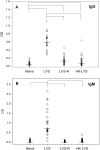A panel of correlates predicts vaccine-induced protection of rats against respiratory challenge with virulent Francisella tularensis
- PMID: 29799870
- PMCID: PMC5969757
- DOI: 10.1371/journal.pone.0198140
A panel of correlates predicts vaccine-induced protection of rats against respiratory challenge with virulent Francisella tularensis
Abstract
There are no defined correlates of protection for any intracellular pathogen, including the bacterium Francisella tularensis, which causes tularemia. Evaluating vaccine efficacy against sporadic diseases like tularemia using field trials is problematic, and therefore alternative strategies to test vaccine candidates like the Francisella Live Vaccine Strain (LVS), such as testing in animals and applying correlate measurements, are needed. Recently, we described a promising correlate strategy that predicted the degree of vaccine-induced protection in mice given parenteral challenges, primarily when using an attenuated Francisella strain. Here, we demonstrate that using peripheral blood lymphocytes (PBLs) in this approach predicts LVS-mediated protection against respiratory challenge of Fischer 344 rats with fully virulent F. tularensis, with exceptional sensitivity and specificity. Rats were vaccinated with a panel of LVS-derived vaccines and subsequently given lethal respiratory challenges with Type A F. tularensis. In parallel, PBLs from vaccinated rats were evaluated for their functional ability to control intramacrophage Francisella growth in in vitro co-culture assays. PBLs recovered from co-cultures were also evaluated for relative gene expression using a large panel of genes identified in murine studies. In vitro control of LVS intramacrophage replication reflected the hierarchy of protection. Further, despite variability between individuals, 22 genes were significantly more up-regulated in PBLs from rats vaccinated with LVS compared to those from rats vaccinated with the variant LVS-R or heat-killed LVS, which were poorly protective. These genes included IFN-γ, IL-21, NOS2, LTA, T-bet, IL-12rβ2, and CCL5. Most importantly, combining quantifications of intramacrophage growth control with 5-7 gene expression levels using multivariate analyses discriminated protected from non-protected individuals with greater than 95% sensitivity and specificity. The results therefore support translation of this approach to non-human primates and people to evaluate new vaccines against Francisella and other intracellular pathogens.
Conflict of interest statement
The authors have declared that no competing interest exist.
Figures







References
-
- Petersen JM, Molins CR. Subpopulations of Francisella tularensis ssp. tularensis and holarctica: identification and associated epidemiology. Future Microbiol. 2010;5(4):649–61. doi: 10.2217/fmb.10.17 . - DOI - PubMed
-
- Staples JE, Kubota KA, Chalcraft LG, Mead PS, Petersen JM. Epidemiologic and molecular analysis of human tularemia, United States, 1964–2004. Emerg Infect Dis. 2006;12(7):1113–8. doi: 10.3201/eid1207.051504 . - DOI - PMC - PubMed
-
- Snoy PJ. Establishing efficacy of human products using animals: the U.S. Food and Drug Administration’s "animal rule". Vet Pathol. 2010;47(5):774–8. doi: 10.1177/0300985810372506 . - DOI - PubMed
-
- Eigelsbach HT, Downs CM. Prophylactic effectiveness of live and killed tularemia vaccines. Journal of Immunology. 1961;87:415–25. - PubMed
-
- Pasetti MF, Cuberos L, Horn TL, Shearer JD, Matthews SJ, House RV, et al. An improved Francisella tularensis live vaccine strain (LVS) is well tolerated and highly immunogenic when administered to rabbits in escalating doses using various immunization routes. Vaccine. 2008;26(14):1773–85. doi: 10.1016/j.vaccine.2008.01.005 . - DOI - PMC - PubMed
Publication types
MeSH terms
Substances
LinkOut - more resources
Full Text Sources
Other Literature Sources
Medical

